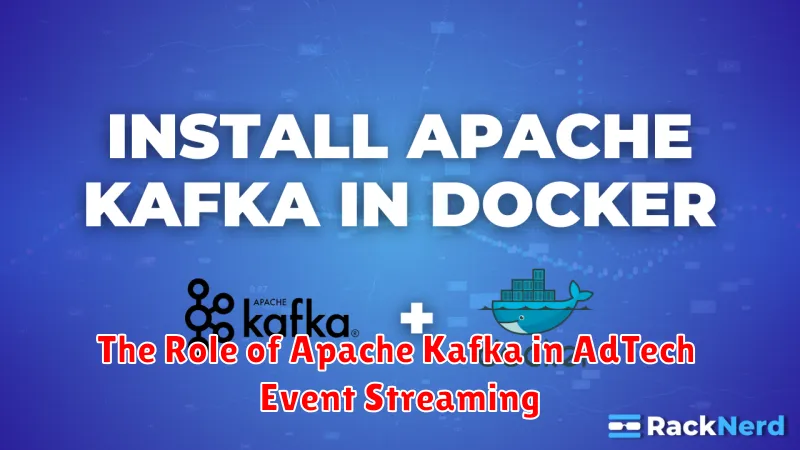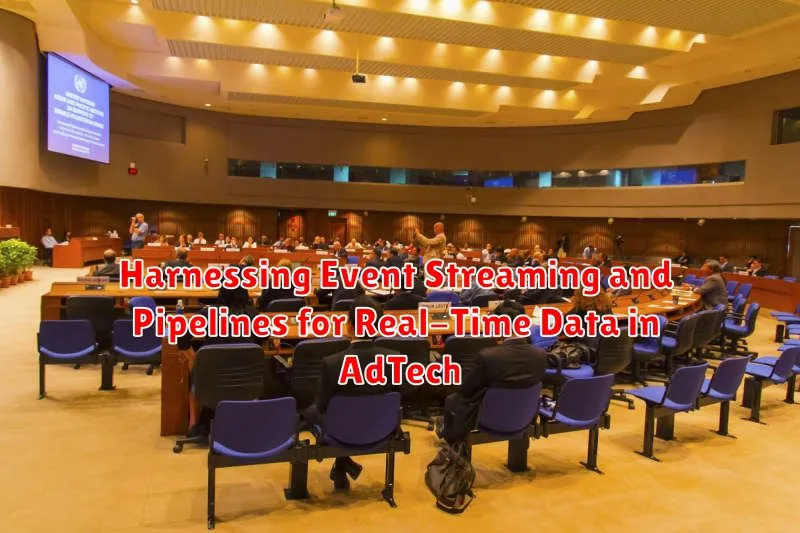The dynamic landscape of AdTech demands instantaneous insights and responses. To stay competitive, organizations are increasingly turning to sophisticated architectures leveraging event streaming and pipelines. This article delves into the critical role of these technologies in handling the massive influx of real-time data generated across advertising platforms. We will explore how harnessing event streaming empowers AdTech companies to process, analyze, and act on information with unparalleled speed and efficiency. This introduction will cover the basic concepts and set the foundation for understanding the implementation of event-driven architectures.
Event streaming platforms, such as Apache Kafka, coupled with robust data pipelines, provide the backbone for ingesting, transforming, and routing real-time data within AdTech ecosystems. This allows for immediate decision-making across various applications, including ad targeting, fraud detection, bid optimization, and performance monitoring. This article will discuss the key components of such architectures, demonstrate practical use cases, and highlight the benefits of adopting event streaming and pipelines to unlock the full potential of real-time data within the AdTech industry. The usage of real-time data and pipelines can optimize the ad targeting for your marketing campaign.
Introduction to Event Streaming in AdTech: What It Is and Why It Matters
In the dynamic landscape of AdTech, event streaming has emerged as a critical technology for capturing, processing, and reacting to data in real-time. Event streaming is a method of capturing data as a continuous flow of events, allowing for immediate analysis and action.
What is Event Streaming? It’s essentially handling data as a continuous stream of records or “events.” Each event represents a state change or occurrence. This is in contrast to batch processing, where data is collected over a period and processed in bulk.
Why does it matter in AdTech? Event streaming enables advertisers and publishers to make faster, more informed decisions. The benefits include:
- Real-time Personalization: Deliver targeted ads based on immediate user behavior.
- Improved Attribution: Accurately track the impact of ads across various touchpoints.
- Fraud Detection: Identify and mitigate fraudulent activities as they happen.
By leveraging event streams, AdTech companies can optimize campaigns, enhance user experiences, and protect revenue streams, resulting in a more efficient and effective ecosystem.
Designing Scalable Event Pipelines for Ad Data

Designing scalable event pipelines for ad data requires a strategic approach to handle the high volume, velocity, and variety of data generated within the advertising technology (AdTech) ecosystem. A well-designed pipeline ensures timely and reliable delivery of ad-related events, enabling real-time decision-making and optimization.
Key Considerations for Scalability:
- Horizontal Scaling: Design components that can be scaled horizontally to accommodate increasing data loads.
- Buffering Mechanisms: Implement buffering layers (e.g., message queues) to handle traffic spikes and prevent data loss.
- Data Partitioning: Strategically partition data to distribute the processing load across multiple nodes.
- Fault Tolerance: Build in redundancy and fault tolerance to ensure pipeline availability.
Choosing the right technologies is also critical. Consider distributed messaging systems and data processing frameworks that are inherently scalable. Careful consideration must be given to data serialization formats and efficient data compression techniques to minimize network bandwidth usage and storage costs. Thorough testing and performance monitoring are essential to identify and address potential bottlenecks before they impact system performance.
Key Components of an Event Streaming Architecture
A robust event streaming architecture comprises several key components working in concert to ensure efficient and reliable data flow.
Event Producers
These are the source systems that generate events. In AdTech, examples include ad servers, user activity trackers, and bidding platforms. The producer’s role is to emit events in a standardized format.
Event Brokers
Event brokers, such as Apache Kafka, act as the central nervous system of the architecture. They receive, store, and distribute events to various consumers. Brokers ensure scalability, fault tolerance, and ordered delivery of events.
Stream Processing Engines
These engines perform real-time transformations, aggregations, and enrichment of event streams. Apache Flink and Apache Spark Streaming are popular choices for this component.
Event Consumers
Consumers are the applications or systems that subscribe to event streams and react to them. Examples include real-time dashboards, personalization engines, and fraud detection systems.
Data Storage
Event data is often persisted in data lakes or data warehouses for historical analysis and reporting.
Real-Time Data Processing: Technologies and Techniques
Real-time data processing is crucial in AdTech for immediate insights and actions. Several technologies are employed to achieve this.
Technologies for Real-Time Processing
Stream processing engines such as Apache Flink and Apache Storm are fundamental. These tools are designed to handle continuous data streams, performing aggregations, transformations, and filtering on-the-fly.
Techniques for Efficient Processing
In-memory data grids like Redis or Memcached are used for fast data access and caching. This minimizes latency when retrieving data for real-time calculations.
Complex event processing (CEP) is another vital technique, which allows the identification of meaningful patterns from multiple data streams. This is particularly useful for fraud detection and personalization efforts.
Integrating Event Streams with Ad Platforms and DSPs
The integration of event streams with Ad Platforms and Demand-Side Platforms (DSPs) is crucial for leveraging real-time data in AdTech. This integration enables immediate responses to user behavior and market changes, optimizing ad campaigns for better performance.
Event streams provide a continuous flow of data points, such as impressions, clicks, and conversions. This data needs to be efficiently ingested and processed by Ad Platforms and DSPs to make informed bidding decisions and personalize ad experiences.
Key Considerations for Integration:
- Data Format Compatibility: Ensuring that event data is formatted correctly for the target platform.
- Low Latency: Maintaining minimal delay between event occurrence and data availability within the platform.
- Scalability: Designing the integration to handle high volumes of event data during peak traffic.
- API Integration: Utilizing APIs provided by Ad Platforms and DSPs for seamless data transfer.
By effectively integrating event streams, advertisers can achieve improved targeting, more accurate attribution, and reduced ad fraud, leading to a higher return on investment.
Use Cases: Personalization, Attribution, and Fraud Detection
Event streaming and pipelines offer transformative opportunities within the AdTech landscape, specifically in personalization, attribution, and fraud detection.
Personalization
Real-time event data enables dynamic ad content modification based on immediate user behavior. For example, product recommendations can adjust instantly based on recent browsing history or purchase events.
Attribution
Event streams facilitate more precise attribution modeling. By capturing every user interaction across multiple touchpoints in real-time, marketers can accurately determine the true value of each channel and optimize campaign spend. This provides a granular view beyond last-click attribution.
Fraud Detection
Real-time analysis of event streams allows for immediate identification and mitigation of fraudulent activities. Anomalous patterns, such as sudden spikes in click-through rates or suspicious IP addresses, can trigger alerts and automated responses to prevent ad fraud.
Ensuring Data Quality and Reliability in Event Streams
Maintaining data quality and reliability is paramount in event streams for AdTech. Inaccurate or inconsistent data can lead to flawed insights, ineffective ad campaigns, and financial losses.
Key Strategies:
- Data Validation: Implement stringent validation checks at each stage of the pipeline to identify and reject malformed or incorrect events.
- Schema Enforcement: Enforce a defined schema to ensure consistency in data structure and types.
- Data Transformation: Apply necessary transformations to standardize and clean data, handling missing values and inconsistencies.
- Monitoring and Alerting: Continuously monitor data quality metrics and set up alerts for anomalies or deviations from expected patterns.
- Error Handling: Implement robust error handling mechanisms to manage failed events and prevent data loss.
By implementing these strategies, AdTech companies can ensure the accuracy, completeness, and consistency of their event streams, leading to better decision-making and improved business outcomes.
Monitoring and Alerting: Keeping Your Pipelines Healthy
Establishing robust monitoring and alerting systems is crucial for maintaining the health and reliability of event streaming pipelines in AdTech. These systems enable proactive identification and resolution of issues, minimizing potential disruptions and data loss.
Key Monitoring Metrics
Critical metrics to monitor include:
- Latency: Track the time taken for events to traverse the pipeline.
- Throughput: Measure the volume of events processed per unit time.
- Error Rate: Monitor the occurrence of errors during processing.
- Resource Utilization: Observe CPU, memory, and disk usage of pipeline components.
- Consumer Lag: Assess the delay in data consumption by downstream applications.
Alerting Strategies
Implement alerting mechanisms based on predefined thresholds for these metrics. Utilize tools like Prometheus and Grafana for visualization and alerting.
Proactive Pipeline Management
Effective monitoring and alerting not only address immediate problems but also provide insights for optimizing pipeline performance and capacity planning. Regularly review metrics and adjust configurations as needed to ensure continuous efficient operation.
The Role of Apache Kafka in AdTech Event Streaming

Apache Kafka has emerged as a cornerstone technology in AdTech event streaming, providing a robust and scalable platform for handling the high-velocity, high-volume data characteristic of the industry. Its distributed, fault-tolerant architecture allows AdTech companies to ingest, process, and distribute event data in real time.
Kafka’s publish-subscribe messaging system enables seamless integration between various AdTech components. Data streams from diverse sources, such as user interactions, ad impressions, and campaign performance metrics, can be efficiently channeled through Kafka topics.
Key benefits of using Kafka in AdTech include:
- Scalability: Handles massive data streams without performance degradation.
- Real-time processing: Facilitates immediate analysis and response to events.
- Fault tolerance: Ensures data reliability even in the event of system failures.
- Decoupling: Enables independent scaling and development of different AdTech components.
By leveraging Kafka, AdTech platforms can build sophisticated real-time applications for personalization, ad targeting, fraud detection, and performance optimization.
Future of Event Streaming: Trends and Innovations
The landscape of event streaming is rapidly evolving, driven by the ever-increasing demands for real-time data processing and analytics in AdTech. Several key trends and innovations are poised to shape the future of this technology.
Cloud-Native Event Streaming: The shift towards cloud-native architectures will continue, with more organizations leveraging managed event streaming services on platforms like AWS, Google Cloud, and Azure. This simplifies deployment, scaling, and management.
Enhanced Stream Processing Capabilities: Expect advancements in stream processing engines, enabling more complex and sophisticated real-time analytics. This includes improved support for machine learning within the stream, allowing for immediate insights and automated decision-making.
Edge Computing Integration: Integrating event streaming with edge computing will become increasingly important for collecting and processing data closer to the source, reducing latency and bandwidth consumption. This is particularly relevant for mobile advertising and location-based services.
Standardization and Interoperability: Efforts towards standardization of event streaming protocols and APIs will improve interoperability between different platforms and systems, fostering a more open and collaborative ecosystem.

